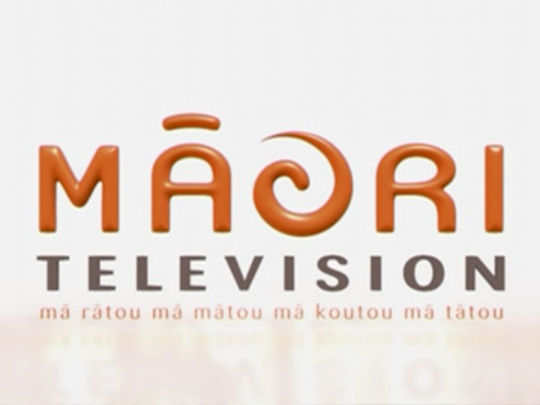
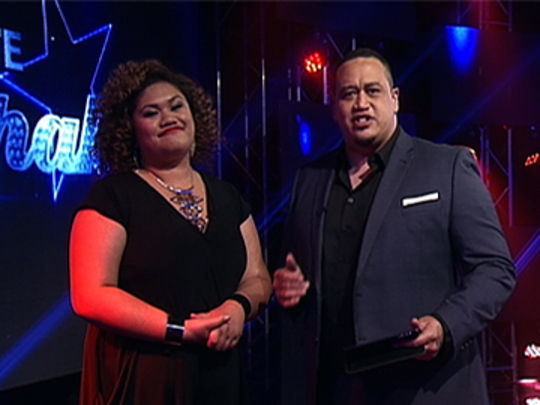
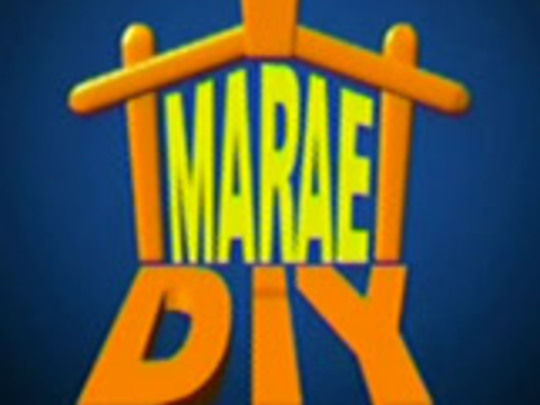
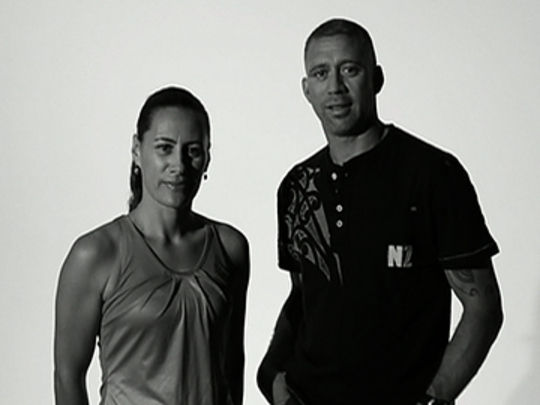
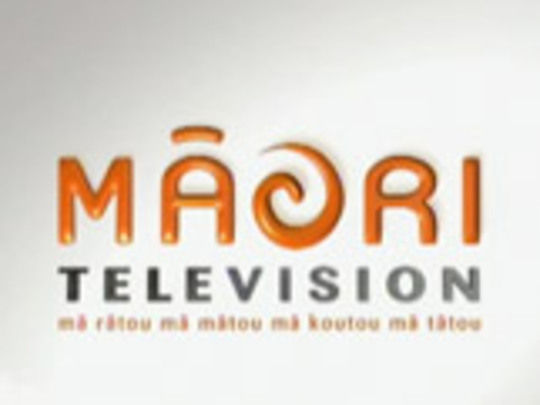
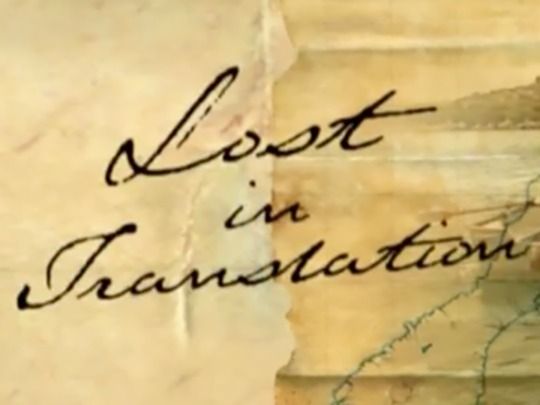
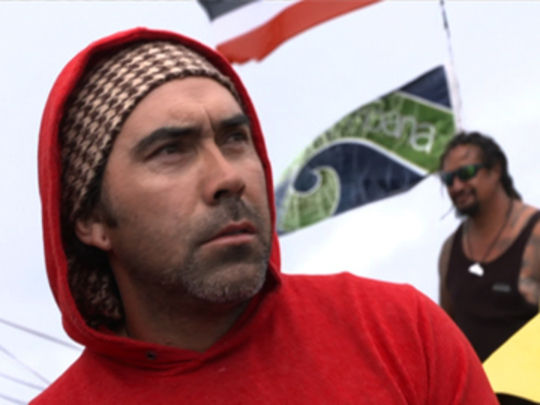
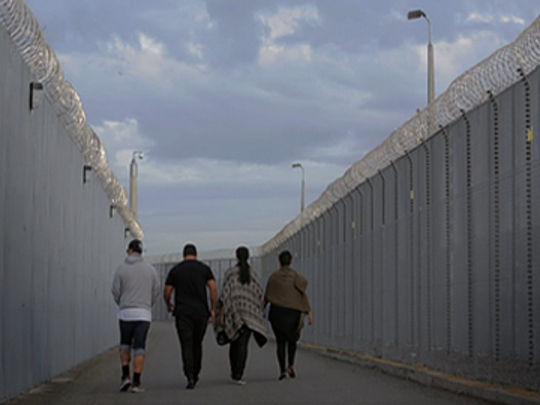
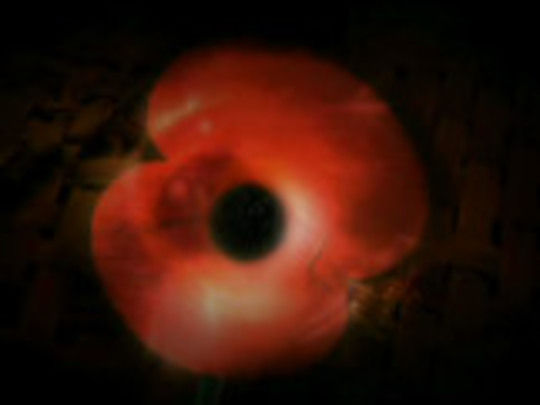
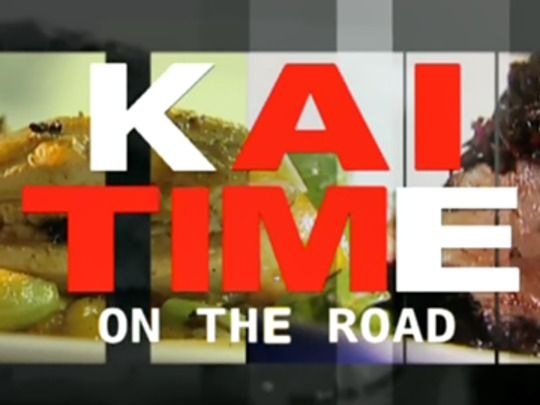
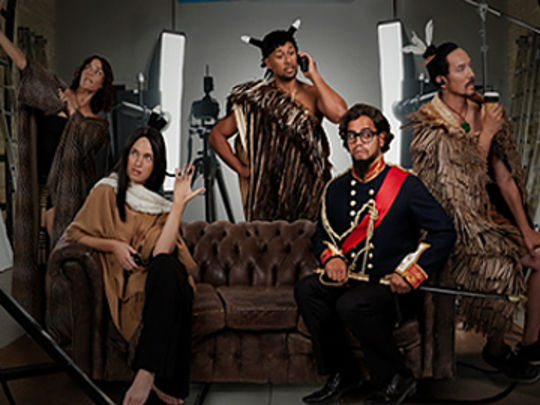
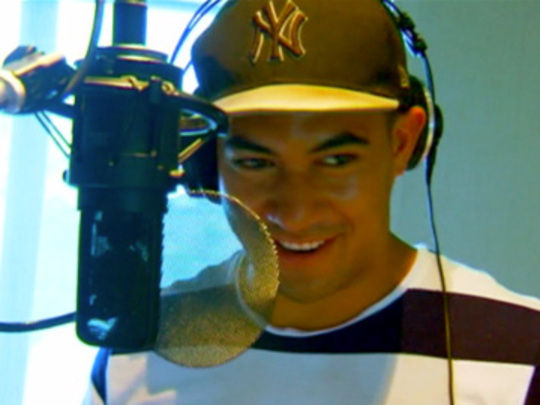
Māori Television Collection
Māori Television Collection
This collection has four backgrounds:
Kia tika. Kia pono. Kia aroha. Kia Māori
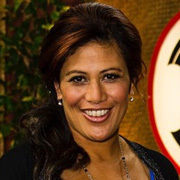
Kia tika. Kia pono. Kia aroha. Kia Māori

The voice of Māori on Television
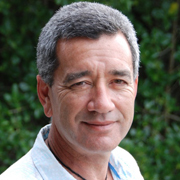
Ko te Māori reo Pouaka Whakaata

Kia tika. Kia pono. Kia aroha. Kia Māori
By Nevak Rogers 31 Oct 2017
Māori Television was launched on 28 March 2004 – the culmination of decades of protests and battles with the crown that went all the way to the Privy Council in London.
For the first time, New Zealand had a broadcaster dedicated to Māori language broadcasting. The Māori Televison Service not only provided a window into the Māori world, it also gave voice to a broader perspective on everything from arts and entertainment to politics and the environment, through a distinctly Māori lens.
The channel’s vision is for te reo Māori to be valued, embraced and spoken by all New Zealanders. Since its inception, Whakaata Māori has set out to educate, inform and entertain viewers to enrich our society, culture and heritage.
In recent years, the Māori Television Service has led the way as New Zealand’s largest free-to-air provider of local content in prime time. MTS has two linear channels – Māori Television (a bilingual channel) and Te Reo (which is mainly in te reo Māori). The network provides content on other platforms, including Māori Television On Demand, a smart app, audio podcasting and livestreaming.
The home of award-winning documentaries, whānau favourites and fresh 'Made in NZ' content, Whakaata Māori is firmly embedded in the country’s media landscape.
This collection is a curation of some of the highlights from the past thirteen years. It spans drama, comedy, entertainment and factual, through to tamariki, language learning shows and coverage of events of national significance.
In 2006 Māori Television’s dedicated coverage for ANZAC Day moved a nation. The welcome return to the screen of Judy Bailey and the poignant interviews of veterans – both Māori and Pākehā – made it a celebration of nationhood. It won a Qantas Award for Best Event Coverage.
The following year, Marae DIY, which debuted on MTS in 2004, picked up a Qantas Award too – up against Police Ten 7 and NZ Idol for Best Reality Series. More importantly, the show has subsequently brought some 100 Māori communities together around the country, to knock out their 10-year renovation and landscaping plans in just four days.
Other flagship series for the channel have included Homai te Pakipaki – a live interactive karaoke series that was hailed as “a show for the people”. Each week queues of people from all over the country would line the streets outside the channel’s Newmarket studio, to compete for a spot on the Homai stage.
Other long-running series such as Code introduced a new twist to sports broadcasting at the channel – where both presenters and guests were accomplished sportspeople. Hunting Aotearoa, Kai Time on the Road and Kōrero Mai became well-known brands in households throughout the motu.
Fast forward to 2017, and there has been a wealth of programming that has entertained and made us laugh – Find me a Māori Bride, The Ring Inz, Game of Bros and Sidewalk Karaoke, to name a few; plus content that’s challenged and made you think – such as Lost in Translation, Native Affairs and Songs from the Inside.
You’ll find that and so much more inside this collection. We hope you enjoy a small taste of what Māori Television has to offer.
- Former journalist Nevak Rogers co-founded Rotorua production company Hula Haka and was behind successful show Marae DIY. After making documentaries on the Polynesian Panthers, Ngā Tamatoa and Māori Television's first decade, she was Māori TV's HOD of Content Development from 2016 to 2018.
Kia tika. Kia pono. Kia aroha. Kia Māori
By Nevak Rogers 31 Oct 2017
I whakamānuhia a Whakaata Māori i te 28 o Poutū te rangi 2004 – te hua whakaharahara o ngā tekau tau e porotēhē ana me te Karauna tae rawa ki te Kaunihera Motuhake i Rānana.
Kātahi anō a Aotearoa ka whiwhi i tētahi kaipāho ngākau nui ki te whakapāho i te reo Māori. Ehara ko te matapihi anake ki te ao Māori ta Whakaata Māori i whakaputa, engari ko te whānuitanga o te titiro ki ngā kaupapa katoa mai i ngā mahi toi me te whakangahau, ki ngā tōrangapū me te taiao, mai i te tirohanga Māori.
Te matapaki a te teihana mo te reo Māori kia ngākaunuihia, kia manaakihia, kia kōrerohia e Ngai Aotearoa. Mai i tōna orokohanga, ka ū a Whakaata Māori ki te ako, te whakamōhio, me te whakangahau i ngā kaimātaki hei whakarangatira i te hapori, te ahurea me te tuku ihotanga.
I roto i ngā tau, ko Whakaata Māori te kaiārahi nui rawa atu o Aotearoa mo te whakapāhō-kore-utu i ngā hōtaka ā rohe i te wā-matua. E rua ngā teihana auaha rārangi a MTS – Ko Whakaata Māori (he hōngere reo rua) me Te Reo (te nuinga kei roto i te reo Māori). Atu i ērā ko ngā pourewa pēnei i a Whakaata Māori On Demand, he SmartApp, he Audio pod-Casting me te whakapāho i-taua wā tonu.
Te kāinga o ngā pakipūmeka-whai tohu, hōtaka whānau me ngā hōtaka hou 'I hangaia i Aotearoa', kua ū taketake nei a Whakaata Māori ki te ao whakapāho o tēnei whenua.
Ko tēnei kōputu he kohinga no ngā tau tekau ma toru kua hipa - he whitinga ki te ao toi whakaari, pakiwaituhi,whakangahau me ngā kōrero pono, tae noa ki ngā hōtaka tamariki,hōtaka whakaako i te reo, me te whakapāho i ngā kaupapa ā motu.
I te 2006 ka whakapāho motuhakehia e Whakaata Māori te Rā o ANZAC, i tangihaku te motu. Mīharo te hokinga mai o Judy Bailey ki te mata whakaatame ngā uiui whakaongaonga a ngā hōia mōrehu — Māori mai Pākehā mai — i whakanuia ā motu. I whakawhiwhia ki te Qantas Award mo te whakaaturanga pāpāho pai rawa atu.
No te tau i muri mai, ka whakaputahia a Marae DIY e MTS i te 2004, otirā i kohia ake te tohu Qantas — i runga ake ī a Police Ten 7 me NZ Idol mo te hōtaka motuhenga pai rawa atu. Ko te mea nui rawa, na tērā hōtaka i whakakao mai ngā hapori Māori kotahi rau o te motu kia whakatinanahia o rātou wawata o ngā tau tekau ki te whakapai i o rātou marae, i roto noa i ngā rā e whā.
Ētahi atu hōtaka nui o te teihana ko Homai te Pakipaki – he hōtaka karaoke i mōhiotia ‘’he hōtaka ma te iwi.’’ Ia wiki tokomaha ngā tāngata o te motu i huihui mai ki waho o te taiwhanga a te teihana nei i Newmarket ki te whakataetae kia tū ki runga i te ātaamira o Homai.
Na ētahi kohinga hōtaka-roa pēnei i a Code i whakauru mai he āhuatanga hou ki ngā whakapāhotanga hākinakina a te teihana – otirā he kaitākaro hākinakina ngā kaiuiui me ngā manuhiri. I tino mōhiotia a Hunting Aotearoa, Kai Time on the Road me Kōrero Mai puta noa i ngā kainga o te motu.
Neke whakamua ki te 2017 he maha ngā hōtaka whaikiko i whakangahau i whakakatakata hoki i a tātou — ko Find me a Māori Bride, The Ring Inz, Game of Bros me Sidewalk Karaoke ētahi; me nga marau hei wero otirā hei whakaohōho whakaaro — pēnei i a Lost in Translation, Native Affairs me Songs from the Inside.
Ka kitea ēnei momo katoa i roto i tēnei kohinga. Te tūmanako ka rata koe ki ta Whakaata Māori e whakapāho atu ana.
- He kairīpoata o mua a Nevak Rogers. Ko ia hoki tētahi o ngā kaiwhakaū pakihi whakaaturanga, arā nāna nei i arataki te hōtaka rongonui a Marae DIY. Ā muri i āna mahi hanga pakipūmeka; Polynesian Panthers, Ngā Tamatoa me ngā tekau tau ō Whakaata Māori ki muri, i tū ia hei Pou Whakawhanake Hōtaka mo Whakaata Māori i te tau 2016.
The voice of Māori on Television
By Tainui Stephens 31 Oct 2017
Māori have long been fond of, and adept at, the use of language. The arts of communication are deployed to explain the world to the people.
One traditional view of Māori broadcasting suggests that it is a vast family tree: In the beginning Thought married Language and begat not just the word, but all forms of communication; from writing, to radio, to film and indeed all modern forms of the media.
On 1 June 1960 television was launched in New Zealand. That very night, entertainment was provided by none other than the Howard Morrison Quartet. That decade saw the broadcast of many forms of Māori entertainment.
However there was a clear lack of any programming that reflected the actual concerns of the Māori world.
During the 1970s things would change markedly, because of the activism of groups like Ngā Tamatoa, the Te Reo Māori Socety and the Waitangi Action Committee. Matters of identity were front of mind at the time. Of particular importance was the loss of the Māori language for the new generations of urban Māori.
In 1972 Hana Jackson and Te Ōuenuku Rene lead a group of mostly students to place a petition upon the steps of the New Zealand Parliament. 30,000 signatories showed their support for action to protect the language. In time it was to be given legal status. It was a love for the language that was to define all subsequent broadcasting endeavours.
In 1973 the country was riveted by the television series Tangata Whenua. This was the first time many Pākehā encountered any insight into aspects of the Māori world. The series offered a vital opportunity for intercultural understanding. We are indebted to this seminal work of director Barry Barclay. He offered a genuine Māori perspective that set a standard for all the productions that were to follow. He believed that in order to preserve Māori integrity in broadcasting, "the camera had to have good manners".
At the beginning of the 1980s producer Ray Waru launched programme Koha. Shortly afterwards Derek Fox and Whai Ngata established the daily Māori news bulletin Te Karere. These productions were a constant presence on the screen, and the nation grew accustomed to the fact of a singular Māori television voice. It was difficult work for these pioneers of broadcasting, because they had few resources.
In that time the Pākehā management of New Zealand television was interested in programming that presented a "window onto the Māori world". Māori however wanted to tell their own stories in their own way to their own people. This was impossible for Pākehā to achieve.
In 1987 another significant Māori language production was broadcast: Waka Huia. Thanks to the determination of producers Ernie Leonard and Whai Ngata, this archival programme preserved important tribal histories for all time. This series is still being produced and is a fine example of television that was less a window for others, than a mirror for the Māori.
In 1996 thanks to Māori insistence, the Aotearoa Television Network was established. It was a pilot endeavor for a standalone Māori channel. It was a challenge to train all the staff required, as well as use a small budget to achieve the desired programming. On 28 March 2004 the Māori Television Service went to air.
From that time the Māori Television Service has grown to a considerable degree. Its main remit is to broadcast programming that supports the language and the culture. There has long been debate about whether television itself can be used to teach the language.
Despite this, the public has been very supportive of the channel. In 2006 two unique television events electrified the country. The first was the live broadcast of the funeral rituals for the late Māori Queen Dame Te Atairangikāhu. The second was extensive programming to mark the war commemorations of Anzac Day. These broadcasts alone were a fine example of Māori television that was utterly indigenous in concept and execution.
Today there are two channels within the Māori Television Service. The first is bilingual, the second is devoted to Māori language programing alone. There is a full menu of terrific programing to be seen at all times: documentaries, sports, dramas and entertainment. The voices of children and youth are heard, and so too are those of our elders. All these things are being achieved by new generations of communicators: descendants all, of the storytellers of yore.
- Tainui Stephens' screen career began on breakthrough Māori show Koha. His work as director includes award-winners Waka Huia and The New Zealand Wars, and Qantas-nominated Kohanga Reo history Let My Whakapapa Speak.
Ko te Māori reo Pouaka Whakaata
By Tainui Stephens 31 Oct 2017
Mai iho mai iho he mea nui ki te Māori ko te whakairoiro i te kupu, me te kawe i te kōrero. Ko tā te kaikōrero he whakamārama nāna i te ao hei whai mōhioranga mai mā te iwi.
Me he tirohanga whakapapa ki te ao whakapāoho Māori arā a tuākana mā, arā a teina mā. Ka moe a Whakaaro ki a Reo ka puta mai a Kupu, otirā ia ka pākarukaru tonu mai ngā momo kawenga o te kupu katoa: Tēnā ko te kawa o te tuhituhi, tēnā ko te kawa o ngā reo irirangi, tēnā ko te kawa o te kiriataata, tēnā ko te kawa whakaata o ngā taputapu pāoho o te wā.
Nō te 1 o Pipiri te tau 1960 i maunu te pouaka whakaata tuatahi o Aotearoa ki runga i te kare o ngā wai whakapāoho. Nō taua pō tonu rā i kitea ko tā te Māori whakangahau. Ko wai atu, ko te Howard Morrison Quartet. Nō ngā tau i muri mai i ngahau anō ai te tūmatanui nā ngā mahi a rēhia a te Māori.
Engari anō ngā take pāoho whaikiko, ngā tū āhua nui o te wā e pā ana ki te Māori ake, kua kore. He māmā noa te kite kei raro kē a Māori e pūtu ana.
Nō ngā tau 1970, i huri te tai, nā ngā mahinga porotehe a ngā rōpū pērā i a Ngā Tamatoa mā, i a Te Reo Māori mā, i a Waitangi Action Committee mā. Ko te tuakiri o te tangata tērā kei te tahiwi o whakaaro. I nui te kōingo mō te reo o whēinga kua mū nei i roto i ngā reanga hou ka noho tāone.
Nō te tau 1972 i whakatakotoria iho e Hana Jackson, e Te Ōuenuku Rene, e te rangatahi Māori mā he petihana mō te whakaoranga o te reo te take. He 30,000 ngā mana tāngata i hainatia ai e rātou taua pepa. I riro ai te wairua tautoko hei huarahi atu ki ngā mana Paremata, ā, me te whakatau mārika i te kī he taonga te reo Māori. Nā wai nā wai i whai mana te reo i raro i te ture. Nā te aroha ki te reo i para huarahi ngā whāinga mō te ao pāoho i muri nei.
Nō te tau 1973 i paohongia te tino whakaaturanga a Tangata Whenua. I ohorere katoa ai ngā iwi o Aotearoa me Te Waipounamu nā tēnei tirohanga whānui mō te ao Māori. He tuatahitanga kē tēnei mō te nuinga o Ngāi Pākehā mā kia kitea ai e rātou ngā kōiriiri o te ao Māori. Nā ēnei whakaaturanga tērā ko te paku hinatore i kitea nei e te motu. Me i kore ake te ringa tohutohu a Barry Barclay me tēnei mahi nui nāna. I rangona tuatahitia ai ko tā te Māori tūturu titiro ki tōna anō ao. Koia tonu ko te tauira i whāia rawahia i muri nei, ka mutu ko tāna i kī nei ‘Kei takahia te mana Māori me mōhio kē te mīhini whakaāhua ki te mana tangata.”
Nō te tīmatanga o te ngahuru tau 1980, nā Ray Waru te whakaaturanga a Koha i whakatere. Nō muri tata mai nā Derek Fox rāua ko Whai Ngata a Te Karere. Nā ēnei hōtaka i kitea nei ia rā, ia wiki, kua taunga haere te motu ki te ahurea a te Māori. Engari tonu he mahi uaua, nā te iti o te pūtea i waiho ai hei mahi mā ēnei toki o te ao whakapāoho Māori.
Nō taua wā ko te whainga matua a ngā rangatira Pākehā o te Pouaka Whakaata, he tautoko i tētahi ‘tirohanga kau mā te ataata mō te ao Māori’. Ko tā te Māori whai he rerekē. Waiho mā te Māori anō āna kōrero hei kawe. E kore rawa e taea e te Pākehā.
Nō te tau 1987, tērā ko te whakaaturanga reo Māori nui whakahirahira i whānau noa mai. Ko Waka Huia tēnei. Nā ngā mahi kipakipa a Whai Ngata rāua ko Ernie Leonard, nā tēnei taonga kohinga kōrero hoki i tāwharau ngā hītori o ngā hapū maha, ā mohoa noa nei. Ko te whakatutukihanga kē tēnei o te ataata e kitea ai te Māori ki a ia anō.
Nō te tau 1996 nā runga i te akiaki o te ao Māori i whakatūngia te Aotearoa Television Network. He whakamātautau tēnei kia tū rangatira he teihana Māori motuhake. He mahi uaua te whakangungu tāngata, me te whakapau pūtea paku noa kia taea ngā wawata whakapāoho. Ā nō te 28 o ngā rā o Poutūterangi i te tau 2004 i maunu ai a Whakaata Māori.
Mai i taua wā i tupu ihiihi i tupu wanawana a Whakaata Māori. Ko te uara matua o Whakaata Māori he tautoko i te reo me ngā tikanga. Kua roa kē ngā tohetohe a ētahi e mea nei e kore e taea e te pouaka whakaata te reo, te ako.
Hāunga tēnei kua aronui mai te marea ki ngā whakaaturanga maha o tēnei teihana. Nō te tau 2006 i rua ngā hōtaka i ohorere katoa ai te motu. Tuatahi ko te whakapāohotanga o te tangihanga mō te Kuini Māori a Te Atairangikāhu. Tuarua ko ngā mihi ko ngā whakaaturanga maha mō te rā whakamaumahara mō Anzac. Nā ēnei kawenga ka rongo tonu te motu ki te manawa Māori ka tukituki ora nei.
Nō tēnei wā he rua ngā ia pāoho a Whakaata Māori. Mā te ia matua e reorua ai ngā hōtaka. Mā te ia tuarua he reo Māori motuhake. E hia rānei nga whakaaturanga ātaahua e kitea ai i te ao i te pō: Pakipūmeka mai, Hākinakina mai, Whakaari mai, Whakangahau mai. Tērā ko te reo pāoho o tamariki mā o taiohi mā, ā tae atu hoki ki a mātāpūputu mā. He mea kapi katoa nā ngā kāwai tāngata, nā ngā kai kawekōrero i whānau noa mai i ngā mana whakaheke o tāukiuki.
- I tīmata ngā mahi pāpāho mata whakaata a Tainui Stephens’ i te putanga tuatahi o te hōtaka Māori nei a Koha. Ētahi hōtaka i whiwhi hōnore i raro i tōna ringa tohu ko Waka Huia ko The New Zealand Wars, me te pakipūmeka Kohanga Reo i tohua ē Qantas, ko Let My Whakapapa Speak.